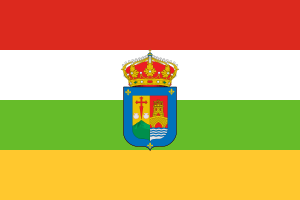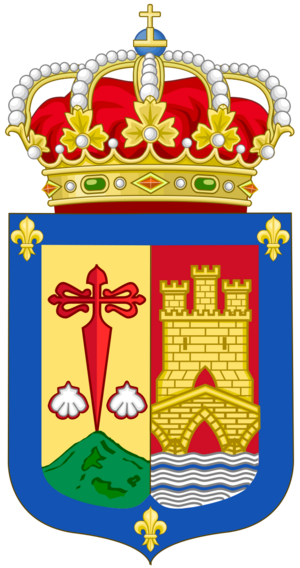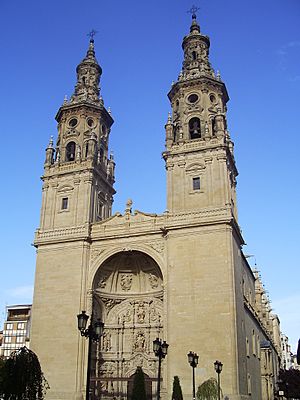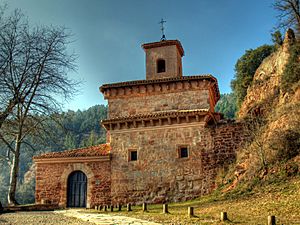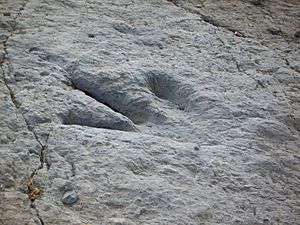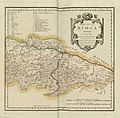La Rioja facts for kids
La Rioja is a special region in Spain that is both an autonomous community (like a state) and a province (like a county). It's located in the northern part of the Iberian Peninsula, which is the landmass where Spain and Portugal are found. The main city and capital of La Rioja is Logroño. Other important cities and towns in the region include Calahorra, Arnedo, Alfaro, Haro, Santo Domingo de la Calzada, and Nájera.
La Rioja is super famous around the world for its delicious wines. The region has a long history of making wine, and its vineyards stretch across beautiful landscapes.
Contents
What is La Rioja Like?
La Rioja is a small but very interesting region. It's known for its beautiful nature, old history, and, of course, its amazing food and drink.
Geography and Nature
La Rioja has a mix of different landscapes.
- Mountains: To the south, you'll find mountains like the Sistema Ibérico, which are part of a larger mountain range in Spain.
- Rivers: The most important river is the Ebro River, which flows through the northern part of the region. Many smaller rivers, called tributaries, flow down from the mountains into the Ebro. These rivers help water the vineyards and farms.
- Climate: The climate in La Rioja is a mix of Atlantic (from the ocean) and Mediterranean (from the sea). This means it has warm, dry summers and cool winters, which is perfect for growing grapes.
A Look at History
La Rioja has a very long history, going back thousands of years.
- Ancient Times: People have lived here since prehistoric times. The Romans also had a strong presence, building roads and towns.
- Middle Ages: During the Middle Ages, La Rioja was a borderland between Christian kingdoms and Muslim territories. Many castles and monasteries were built during this time.
- Modern Era: La Rioja became an official autonomous community in 1982. This means it has its own government and can make many decisions for itself, while still being part of Spain.
Culture and Traditions
The culture of La Rioja is rich and full of traditions, many of which are linked to its history and its famous wine.
The Famous Wine of La Rioja
La Rioja is one of the most important wine regions in the world.
- Grape Varieties: The main red grape used is Tempranillo, which gives the wine its special flavor. Other grapes like Garnacha, Mazuelo, and Graciano are also used. For white wines, Viura is common.
- Wine Making: The region has strict rules about how wine is made to ensure its quality. Wines are often aged in oak barrels, which gives them a unique taste.
- Wine Tourism: Many people visit La Rioja to explore its vineyards, visit wineries, and taste different wines. There are also wine museums, like the Vivanco Museum of Wine Culture.
Festivals and Celebrations
People in La Rioja love to celebrate!
- Haro Wine Festival: One of the most famous festivals is the Haro Wine Festival, also known as the "Battle of Wine." People throw wine at each other in a fun, friendly battle.
- San Mateo Festival: In Logroño, the capital, the San Mateo Festival is a big harvest celebration, especially for grapes. There are parades, music, and traditional events.
- Local Fiestas: Almost every town and village has its own special festival, often celebrating a patron saint or an important local product.
Important Places to Visit
La Rioja has many interesting places, from ancient monasteries to dinosaur footprints.
Logroño: The Capital City
Logroño is the biggest city in La Rioja and its capital.
- Old Town: The historic center of Logroño is great for walking around. You can see old churches, like the Church of San Bartolomé and the Santa María de la Redonda Co-cathedral.
- Food and Drink: Logroño is famous for its "pinchos" (small snacks, similar to tapas) and its lively streets, especially Calle Laurel, where you can try many different local foods.
Monasteries of San Millán de la Cogolla
These two monasteries, Suso and Yuso, are a UNESCO World Heritage Site.
- Suso Monastery: This older monastery dates back to the 6th century. It's important because it's where the first words written in Spanish and Basque languages were found.
- Yuso Monastery: Built later, this larger monastery is still active. It has a beautiful library and a museum.
Dinosaur Footprints
La Rioja is a great place for dinosaur fans!
- Fossil Sites: The region has many sites with dinosaur footprints, especially near towns like Enciso. These footprints are from millions of years ago, showing that dinosaurs once roamed here.
- Paleontological Routes: There are special routes you can follow to see the footprints and learn about the dinosaurs that made them.
Famous People from La Rioja
- Fausto Elhuyar: Born in Logroño, Fausto Elhuyar was a famous chemist. Along with his brother Juan José Elhuyar, he discovered the element tungsten in 1783.
Images for kids
-
The river Ebro in La Rioja
-
Battle of Wine in Haro (La Rioja)
-
Regional road LR-210 towards San Vicente de la Sonsierra
-
Fausto Elhuyar (1755–1833), chemist and joint discoverer of tungsten with his brother Juan José Elhuyar
-
Portal of Church of San Bartolomé (Logroño)
See also
 In Spanish: La Rioja (España) para niños
In Spanish: La Rioja (España) para niños


